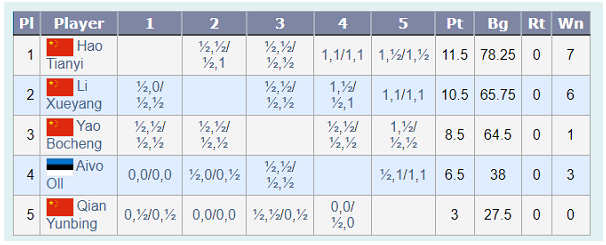By Aivo Oll
This was the first official tournament with this exciting rule.
Once again, here is the rule description:
The black player puts the first move in the center of the board.
The other player may swap.
The white player will put the 2nd move within 5×5 central square.
The other player may swap.
The black player will put the 3rd move within 7×7 central square.
The other player may swap.
The white player will put the 4th move within 9×9 central square.
The choice 1 (after the 4th move):
The other player may swap.
The black player will put the 5th move within 9×9 central square.
The other player may swap.
The white player plays the 6th move anywhere on board.
The choice 2 (after the 4th move):
The black player puts 10 fifth moves anywhere on board (symmetrical moves are not allowed).
The white player chooses one of the offered 5th moves and plays the 6th move anywhere on board.
The game continues with the renju rule.
What makes the rule exciting and new is that new openings are possible. Instead of 26 openings, now there are more than 150 openings possible. I think this is a very good rule for the future. Not only for correspondence games but also live games.
About the tournament itself:
Me and Hao Tianyi organized the tournament and tried to find 5 strong players. We decided to play a quadruple Round Robin. Time control was 100 days per game, 30 days per move. The main favourites of the tournament were Hao Tianyi himself and Li Xueyang. In the end, Hao Tianyi managed to win a game against Li and that was one of the best games of the tournament.
I will try to comment on some of the most interesting games of the tournament.
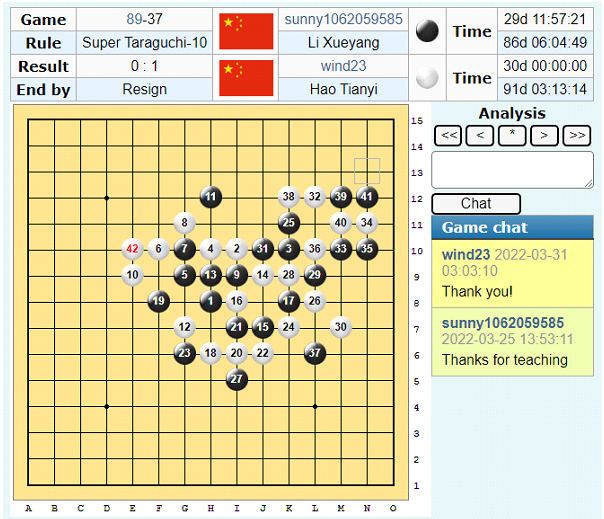
Li Xueyang placed a very sharp opening against Hao Tianyi. At first glance, the position seems to favour black. Still, Hao managed to find the best continuation for white and Li was in trouble soon. After 42 there is no defence anymore.
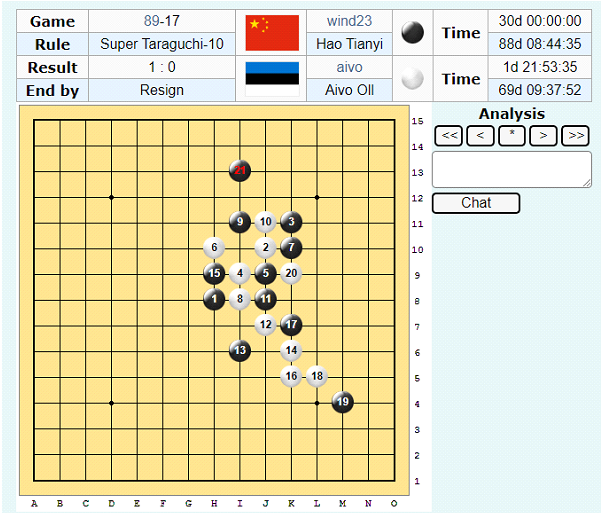
This was my worst game of the tournament. Not only did I give up in a position where there is defence for white but in the end, white even has a slight advantage. Here is how the position would look like if I had found the correct continuation:
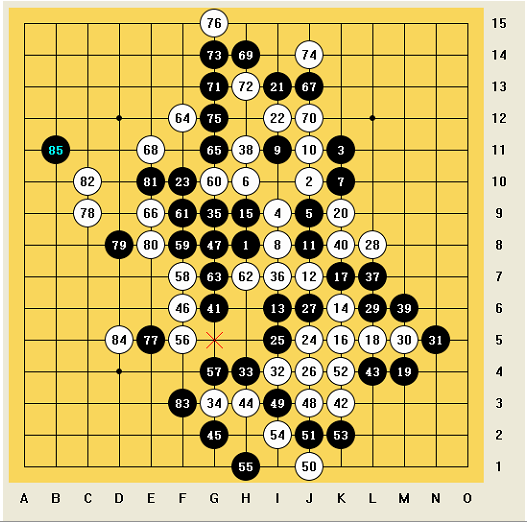
As you can see, the position is very sharp. 22 is the only move that defends.
Here is a game of mine with Li Xueyang:
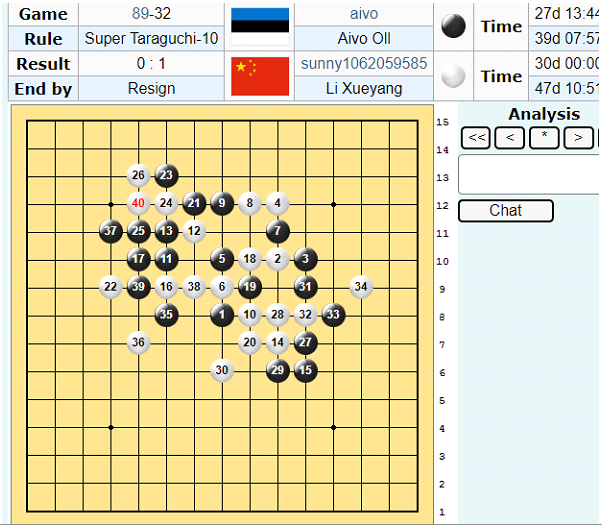
Li easily won the game thanks to finding the best 14th, 16th, 18th and 20th move. After that black is in dire straits already. He also used the same variant against Qian Yunbing and won that game easily as well.
Here is the best game of mine in the tournament, against Qian Yunbing:
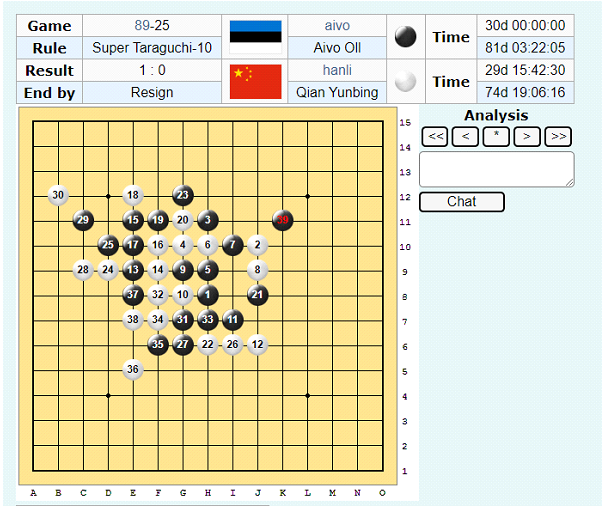
Qian placed a bit too strong 5th move for black but it was not easy to find a good plan. Finally,
I found the win using Rapfi, not Katagomo.
Here is a brilliant game between Hao Tianyi and Qian Yunbing:
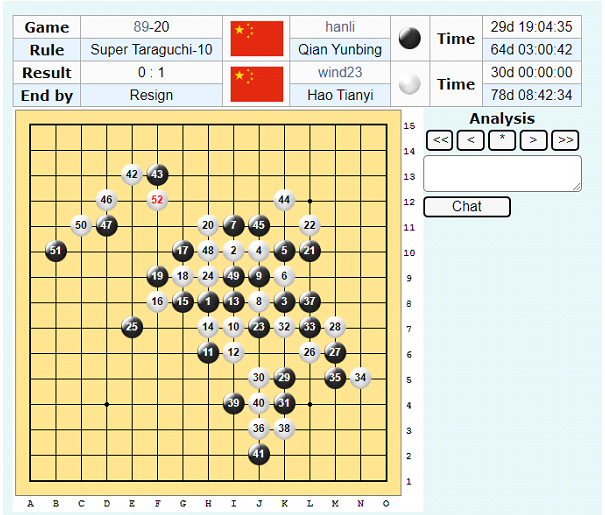
The variant itself is quite balanced but Hao managed to find a very good plan for white. 42 is an amazing move.
Overall, the rule is good for both players who want to play older variants and those who want to experiment with new variants. This is the rule of the future for sure. Perhaps for correspondence it can be used already in a few years if the draw rate with Taraguchi-10 becomes too high.
Here is my evaluation of the players who participated in the tournament:
Hao Tianyi: 5
He did not lose a single game in the tournament and did a lot of damage against me. His playing style is very impressive and the variants he chose were quite tricky as well.
Li Xueyang: 4
I was expecting a bit more from one of the best correspondence players in the world. He rarely loses a game, but this time Hao was definitely better than him.
Yao Bocheng: 3
The most boring player of the tournament. He mostly put old Taraguchi-10 variants on the board and from 16 games made 15 draws! His only win came against Qian Yunbing.
Aivo Oll: 2
I should have drawn at least 3 games against Hao Tianyi but made too many stupid mistakes against him. I played too fast and sloppy and that was the main reason why I got only 6.5 points.
Qian Yunbing: 1
I was expecting a lot more from the 2nd place of last year´s correspondence World Championship participant. Perhaps he did not take the tournament very seriously or did not have much time.
Nowadays if you want to compete for the best place in correspondence tournaments, you need to use the strongest programs (Katagomo, Rapfi, Embryo etc.). Without these programs it is almost impossible to win the tournament. Also, at least when it comes to Katagomo, you need to have a powerful PC with a good graphics card. In the last few years, the renju theory research has totally changed and that has a lot to do with these new programs, especially Katagomo. Katago is a go program, and a similar program was made for both gomoku and renju and it was named Katagomo. The creator of the program is from China, and it is updated regularly. Also, it does not cost anything to download the program but like I mentioned earlier, a good computer is needed to use it efficiently.
I would like to give special thanks to all the players who participated in this tournament. Especially Hao Tianyi who has helped me a lot with Correspondence World Championship and without his site Renju Caffe it would not be possible to have these tournaments at all.
Aivo Oll


